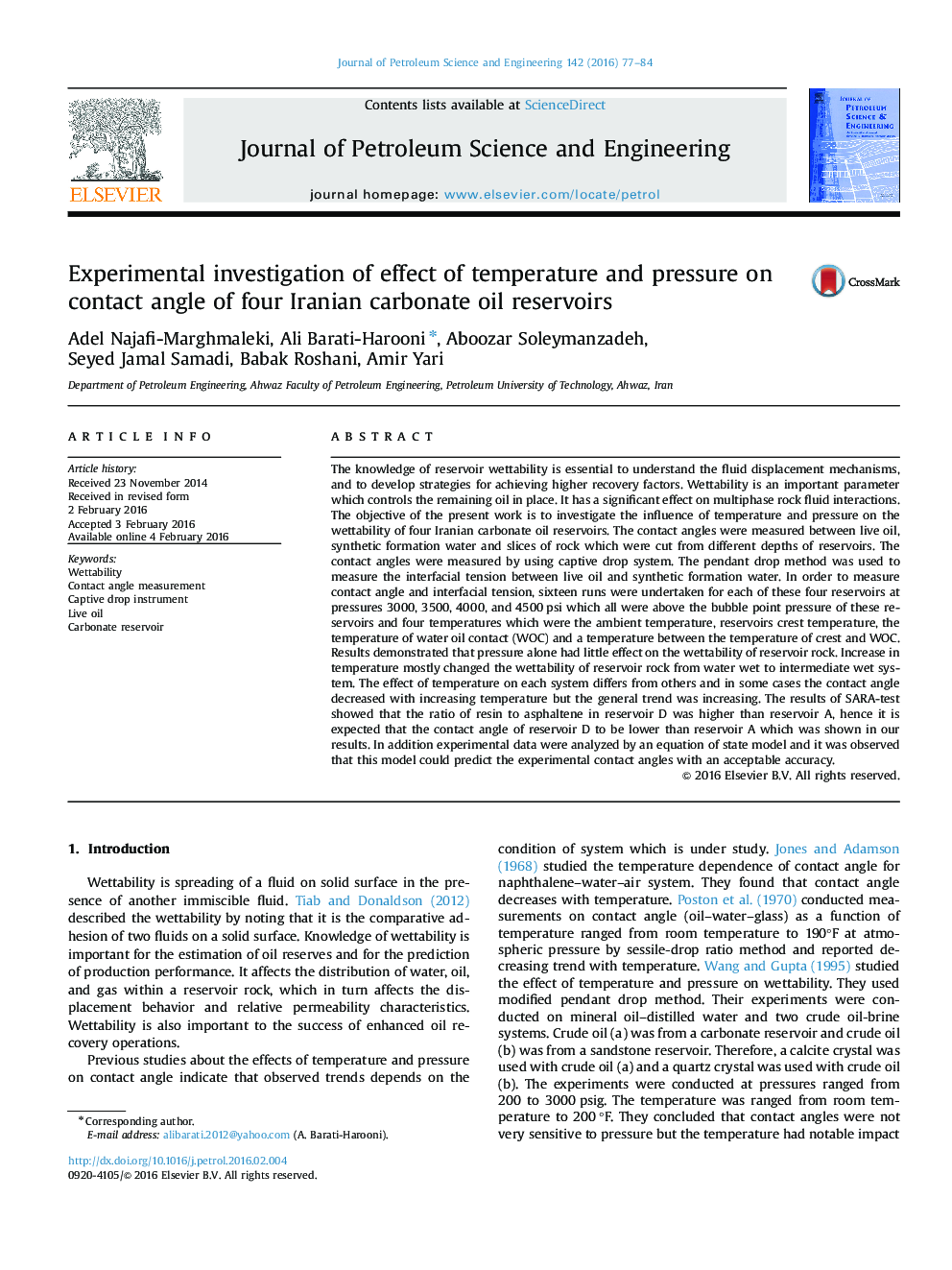| Article ID | Journal | Published Year | Pages | File Type |
|---|---|---|---|---|
| 1754551 | Journal of Petroleum Science and Engineering | 2016 | 8 Pages |
•Real reservoir rocks and fluids were used to investigate the effect of temperature and pressure on contact angle of four Iranian carbonate oil reservoirs, namely A, B, C and D.•Pressure has no significant effect on contact angle of these reservoirs. Increase in temperature generally increased the measured contact angles•The contact angle data were fitted by an equation of state model and it was found that the model could reproduce the results with an acceptable accuracy.
The knowledge of reservoir wettability is essential to understand the fluid displacement mechanisms, and to develop strategies for achieving higher recovery factors. Wettability is an important parameter which controls the remaining oil in place. It has a significant effect on multiphase rock fluid interactions. The objective of the present work is to investigate the influence of temperature and pressure on the wettability of four Iranian carbonate oil reservoirs. The contact angles were measured between live oil, synthetic formation water and slices of rock which were cut from different depths of reservoirs. The contact angles were measured by using captive drop system. The pendant drop method was used to measure the interfacial tension between live oil and synthetic formation water. In order to measure contact angle and interfacial tension, sixteen runs were undertaken for each of these four reservoirs at pressures 3000, 3500, 4000, and 4500 psi which all were above the bubble point pressure of these reservoirs and four temperatures which were the ambient temperature, reservoirs crest temperature, the temperature of water oil contact (WOC) and a temperature between the temperature of crest and WOC. Results demonstrated that pressure alone had little effect on the wettability of reservoir rock. Increase in temperature mostly changed the wettability of reservoir rock from water wet to intermediate wet system. The effect of temperature on each system differs from others and in some cases the contact angle decreased with increasing temperature but the general trend was increasing. The results of SARA-test showed that the ratio of resin to asphaltene in reservoir D was higher than reservoir A, hence it is expected that the contact angle of reservoir D to be lower than reservoir A which was shown in our results. In addition experimental data were analyzed by an equation of state model and it was observed that this model could predict the experimental contact angles with an acceptable accuracy.
Graphical abstractThe knowledge of reservoir wettability is essential to understand the fluid displacement mechanisms, and to develop strategies for achieving higher recovery factors. Wettability is an important parameter which controls the remaining oil in place. It has a significant effect on multiphase rock fluid interactions. The objective of the present work is to investigate the influence of temperature and pressure on the wettability of four Iranian carbonate oil reservoirs. The contact angles were measured between live oil, synthetic formation water and slices of rock which were cut from different depths of reservoirs. The contact angles were measured by using captive drop system. The pendant drop method was used to measure the interfacial tension between live oil and synthetic formation water. In order to measure contact angle and interfacial tension, sixteen runs were undertaken for each of these four reservoirs at pressures 3000, 3500, 4000, and 4500 psi which all were above the bubble point pressure of these reservoirs and four temperatures which were the ambient temperature, reservoirs crest temperature, the temperature of water oil contact (WOC) and a temperature between the temperature of crest and WOC. Results demonstrated that pressure alone had little effect on the wettability of reservoir rock. Increase in temperature mostly changed the wettability of reservoir rock from water wet to intermediate wet system. The effect of temperature on each system differs from others and in some cases the contact angle decreased with increasing temperature but the general trend was increasing. The results of SARA-test showed that the ratio of resin to asphaltene in reservoir D was higher than reservoir A, hence it is expected that the contact angle of reservoir D to be lower than reservoir A which was shown in our results. In addition experimental data were analyzed by an equation of state model and it was observed that this model could predict the experimental contact angles with an acceptable accuracy.Figure optionsDownload full-size imageDownload as PowerPoint slide
